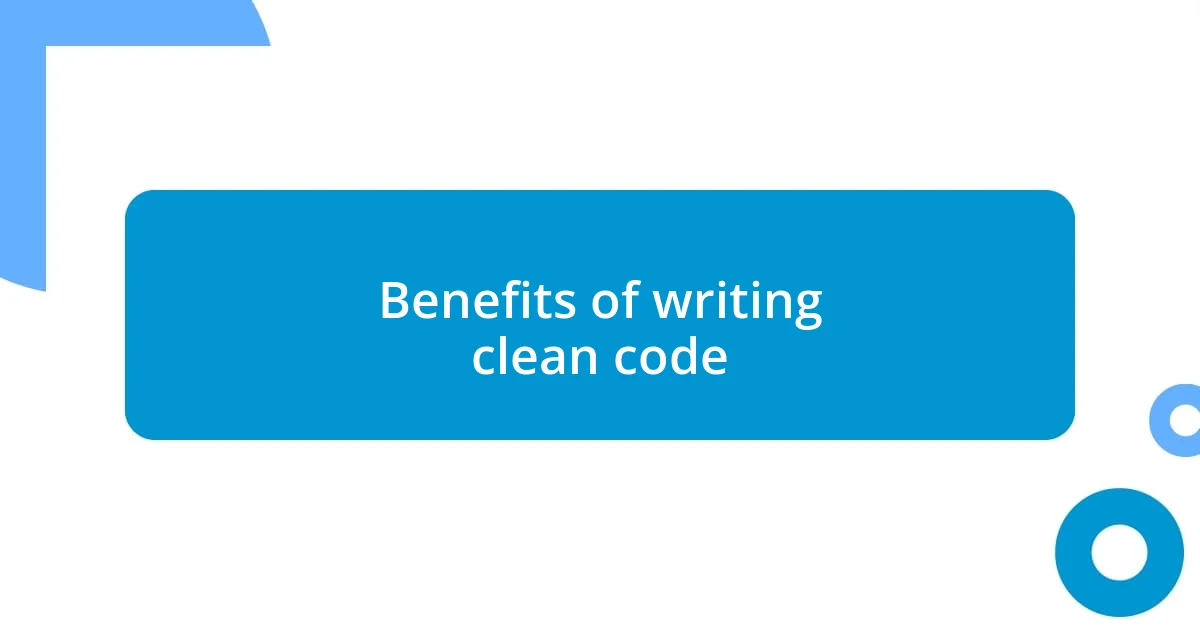Key takeaways:
- Writing clean code enhances readability, maintainability, and collaboration, enabling faster onboarding and efficient problem-solving.
- Adopting meaningful naming conventions and consistent formatting creates clarity, reducing confusion and promoting teamwork among developers.
- Regular refactoring, unit testing, and embracing code reviews are vital practices that improve code structure and foster a culture of quality and continuous improvement.

Understanding clean code principles
Clean code principles revolve around writing code that is not just functional but also understandable and maintainable. I remember when I first encountered a massive codebase without clear naming conventions; it felt like trudging through a dense fog. It struck me then how vital it is for naming variables and functions to convey their purpose clearly—after all, shouldn’t our code speak for itself?
One key principle is simplicity. I often ask myself, “Is this the simplest way to achieve the goal?” In my experience, when I simplify my code, I not only eliminate potential bugs but make it much easier for others (and future me) to read and collaborate on. Just the other week, I refactored a convoluted function into a more straightforward one. It took a bit of time upfront, but the clarity it brought made those later team discussions so much more productive.
Another fundamental tenet is consistency. Think about this: if you opened up a book and the author suddenly changed their writing style chapter by chapter, how confused would you feel? Code is no different. Maintaining consistent formatting, naming conventions, and structure not only enhances readability but creates a sense of stability for anyone working with your code. I’ve found that adhering to a style guide, like Google’s C++ Style Guide, really helps instill a shared understanding among team members, promoting a smoother workflow.

Benefits of writing clean code
Writing clean code brings a plethora of benefits, starting with enhanced readability. I recall when I joined a new project full of tangled spaghetti code; it felt like trying to decipher an ancient language. Clean code, on the other hand, reads like a well-crafted story—it allows developers to understand what’s happening quickly. This clarity means that new team members can onboard faster and existing members can troubleshoot or enhance features with ease.
Another significant advantage is improved maintainability. I’ve experienced firsthand how difficult it can be to change features in a poorly written codebase. It’s like trying to change the tires on a moving car — chaotic and risky. When the code is clean, even substantial modifications can be done with confidence, leading to less frustration and increased productivity. I’ve been part of several projects where we managed to implement significant enhancements, thanks largely to the clean structure established at the outset.
Lastly, let’s talk about collaboration. A codebase that follows clean code principles fosters a more cooperative environment. During a recent team sprint, we encountered a critical bug. Instead of panic, we gathered around the code with confidence. Everyone could quickly grasp the logic, pinpoint issues, and propose solutions, allowing us to fix the problem in record time. This smooth collaboration wouldn’t have been possible if our code hadn’t been clean and organized.
| Benefit | Description |
|---|---|
| Readability | Clean code is easy to read and understand, allowing developers to quickly grasp functionality. |
| Maintainability | It simplifies making changes and improvements, reducing frustration and increasing efficiency. |
| Collaboration | An organized codebase promotes teamwork and effective problem-solving among developers. |

Key practices for clean code
Key practices for clean code involve several essential habits that can genuinely transform your coding experience. One of the most impactful practices for me has been the use of meaningful names. I vividly remember a time when I encountered a variable named “x” in a team project. What did “x” even represent? Switching to descriptive names completely changed the way we approached our code. Suddenly, it felt like we were all on the same page. When developers can easily identify the purpose of variables and functions through their names, it cuts down on confusion and fosters teamwork—something I value deeply in any project.
Here are some key practices to keep in mind for maintaining clean code:
- Use meaningful names: Choose variable and function names that clearly express their purpose.
- Comment wisely: Use comments to clarify complex logic, but avoid stating the obvious, so code remains self-explanatory.
- Keep functions short: Aim for functions that perform a single task, making them easier to understand and test.
- Write tests: Incorporate unit tests to affirm that your code functions as expected, contributing to maintainability.
- Refactor regularly: Set aside time to periodically revisit and improve your code to enhance readability and performance.
I also find that adhering to standard conventions, like a consistent code style, pays dividends. When working on a recent project with a diverse team, we adopted a common code format. At first, I thought, “Do we really need this?” But in the end, it streamlined our workflow significantly. Having a shared understanding of what the code structure looks like allows us to jump in and help each other without hesitation. It’s moments like these that epitomize the beauty of clean code—it’s not just about the code; it’s about building a collaborative environment where everyone contributes effortlessly.

Code readability and organization
When I think about code readability and organization, I can’t help but recall a time when I inherited a project where the layout felt like a maze. The lack of structure not only slowed me down but also left me feeling overwhelmed. I realized then that a well-organized codebase acts like a roadmap, guiding developers through the logic without the need for a magnifying glass. It highlights the importance of consistent formatting and indentation, which make locating functions and understanding flow a breeze.
One practice that has served me well is using whitespace effectively. A cluttered page of code can be frightening. But with ample spacing, I find that I can see the relationships between functions more clearly. It’s like stepping back from a canvas to appreciate the whole picture instead of getting lost in the details. Have you ever taken a moment to just breathe and look at your code from a distance? When you do, organization jumps out at you—it’s so much easier to identify areas for improvement.
Moreover, I always emphasize the importance of grouping related functions or classes. This small change makes a huge impact on how intuitively someone can navigate the code. During a particular project, we decided to categorize our modules based on functionality. This not only made it easier for the team to find what they needed but also fostered a sense of ownership. Everyone felt more connected to their parts because, in a clean, organized environment, it’s clear how each piece contributes to the whole. Imagine working on a puzzle where the pieces fit smoothly together—that’s what a well-structured codebase feels like.

Naming conventions for clarity
When it comes to naming conventions, I’ve seen firsthand how a simple, yet thoughtful, approach can transform the clarity of code. For instance, I once worked with a developer who named a function “doStuff.” I remember thinking, “What kind of stuff?” It was frustrating to decipher its purpose. After we collectively adopted a convention of using specific action-oriented names, like “calculateTotal” or “fetchUserData,” our productivity skyrocketed. I couldn’t believe the difference it made when everyone was immediately aware of what each function was intended to accomplish—it was like shifting from a cryptic language to plain English.
In addition to being descriptive, I’ve learned that consistency in naming is vital. During a recent collaboration, we agreed on a set format: camelCase for variables and PascalCase for classes. Initially, I thought it was a small detail, like a footnote in a lengthy chapter, but I soon realized it made life so much easier. When I could glance at the code and effortlessly identify whether something was a variable or a class, it reduced the mental overhead considerably. I often wonder, how much mental energy do we waste trying to decipher sporadically named elements? That clarity allowed us to focus on writing better code instead of untangling a mess of identifiers.
I’ve also discovered the power of context in naming. Recently, while refactoring a project, I found a variable dubbed “temp.” At first glance, it felt utterly vague. However, when I took a moment to rename it to “temporaryUserSession,” it immediately provided context and relevance. This small act not only clarified my own thought process but also made it much easier for others diving into the code later. Have you ever experienced the satisfaction of seeing code that feels like it tells a story? When we embrace meaningful names, we create a narrative around our logic, inviting others in rather than pushing them away.

Refactoring techniques for improvement
Refactoring is all about improving the internal structure of our code without altering its external behavior. I remember a time when I tackled a particularly knotty piece of code filled with duplicate logic. By extracting common functionality into reusable methods, I not only simplified the code but also made it much easier to maintain. Have you felt the relief of deleting repetitive sections? It’s like clearing out clutter from a workspace—suddenly, there’s room to think clearly.
One technique I’ve embraced is the practice of breaking down large functions or classes. In a previous project, I had a method that was over 100 lines long. I took the plunge to refactor it into smaller, purpose-driven methods. This approach brought to light not only separate functionalities but also improved readability tremendously. When I observe code in smaller, digestible pieces, I feel more confident in understanding and making changes. Have you ever feared diving into a massive function, only to find yourself lost midway? Simplifying reduces that anxiety and encourages a more fearless exploration of the codebase.
Another strategy I’ve found invaluable is embracing the ‘boy scout rule’: always leave the code cleaner than you found it. It feels like a personal mission each time I write or revise a section of code. For instance, while reviewing my last feature implementation, I took a moment to clean up outdated comments and enhance variable names. Not only did it elevate the overall quality, but I felt a sense of pride in taking small steps towards maintaining a tidy codebase for my team. Isn’t there something rewarding about knowing we are not just code authors but also caretakers of a clean, efficient environment?

Testing strategies for clean code
In my experience with testing strategies for clean code, I’ve found that unit testing is a cornerstone. A vivid memory that stands out is when I implemented unit tests in a project that had previously been riddled with bugs. I remember the initial skepticism of my teammates, but after seeing our bug rate plummet, it was like a light bulb moment for everyone involved. Have you ever witnessed a transformation like that? The confidence to make changes without the fear of breaking things was a game changer for us.
Integration testing has also played a vital role in my coding journey. During a significant project, we decided to test how different modules interacted with one another. I vividly recall the initial tests uncovering hidden dependencies that had gone unnoticed. It was an eye-opening experience. Each time we caught a failure during integration testing before it reached production, I felt like we were dodging a bullet. Isn’t there something particularly satisfying about catching issues early and avoiding the chaos of last-minute fixes?
Finally, I’ve learned the importance of code reviews in maintaining clean code. There was a time when I received feedback on a complex function I had written, and I initially felt defensive. However, as I opened up to my colleague’s suggestions, I realized they improved my code significantly. I began to view code reviews not as criticism, but as collaborative growth. Isn’t it incredible how fresh eyes can spot improvements we often overlook in our own work? Embracing this aspect of teamwork has truly enriched my coding experience.












